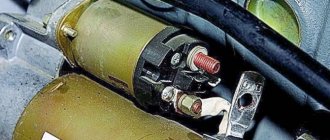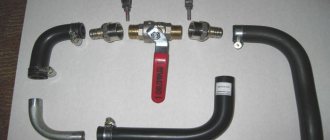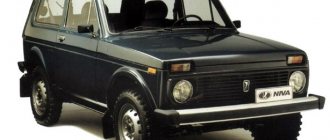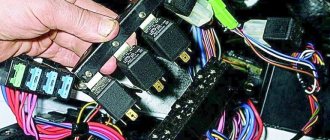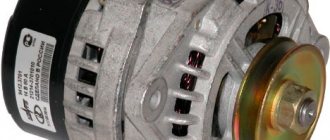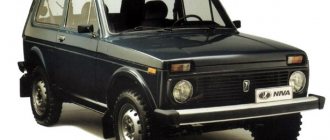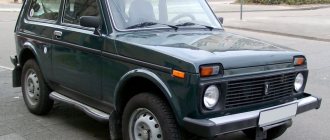VAZ-21213 (Niva). Removing and installing the clutch
GENERAL INFORMATION Centering the clutch driven disc using mandrel A.70081
| 1 – thrust flange of the pressure spring; 2 – central pressure spring; | 3 – pressure disk; 4 – ring |
EXECUTION ORDER1. Clutch control is carried out on a base that imitates an engine flywheel and has a metal intermediate ring 4 with a thickness of 8.2 mm, which replaces the driven disk (see Fig. Clutch control). 2. After securing the clutch cover, perform four release strokes equal to 8–9 mm.
The shutdown stroke of 8 mm should correspond to a movement of the pressure plate of 1.6–1.7 mm (the smallest allowable is 1.4 mm). 3. The distance from the base to the working surface of the friction ring of the thrust flange should be 40–43 mm. 4. During operation, due to wear of the rubbing surfaces of the clutch discs, this size increases. 5.
If it reaches 48 mm or the pressure plate moves less than 1.4 mm, replace the clutch housing and pressure plate assembly. 6. Replace the friction linings of the driven disk when cracking appears, the distance between the rivet and the working surface decreases to 0.2 mm, as well as when burrs occur on one side.
| 7. When repairing driven disk 2 and replacing friction linings, use tool 67.7822.9529 – 1 (3 – jig 67.7822.9517). |
8. Flared rivets should not have breaks. 9. The runout of the working surface of the friction linings should not exceed 0.5 mm.
| 10. If it is larger, then straighten the disk or replace it with a new one. |
11. If cracks appear on the driven disk or damper springs, replace the driven disk assembly. contents .. 41 42 43 ..
How to replace a Niva Chevrolet clutch with your own hands
The easiest way to deal with any breakdown is to contact a service station. Clutch problems can be fixed there in just a couple of hours. But there is another way that will help you save money - repairing the car yourself.
Let's start with the main thing
Let's figure out what clutch is. This is a device for changing gears in a car. When it fails, other components suffer: the gearbox and even the engine. In addition, each car has a drive (front or rear). The Chevrolet Niva has a full hydraulic drive. This will create additional difficulties. But if we have taken it upon ourselves, we will not retreat.
Next, let's take a look at possible clutch failures. For example, when a Chevrolet Niva’s clutch “slips,” the reasons may be:
- Burnout or severe wear of the linings. In such a situation, the disk needs to be replaced.
- Oil on the driven disc linings. Then we look for where the oil is leaking, eliminate the leak, and also wash the discs.
- There are situations when the clutch “leads”. This happens due to its partial shutdown. What's the matter here:
- the appearance of end runout or deformation of the driven disk. The optimal solution would be to replace the disk with a new one;
- air entering the hydraulics. In this case, you will need to bleed the system;
- the pressure plate is warped, then there is no option - change it;
- loosening the rivets of the linings. Only by replacing the entire set with a new one can the problem be solved;
- Broken pressure fork. May need replacement.
There are also such options: noise when pressing the clutch or when releasing the pedal. Still, there is no way to do it without disassembling the entire system.
How to replace the clutch in a Niva Chevrolet car
The main thing in this matter is patience and following the instructions exactly. And now the repair step by step:
- we stop at the inspection hole;
- remove the gearbox;
- if you decide not to change the pressure plate, then make notes about the location of the flywheel and casing;
- take a 8mm wrench and unscrew all the bolts that secure the disc to the flywheel. This can be done if the flywheel is held motionless;
- remove the driven and pressure disks;
- if there are signs of wear on the driven disk, then it needs to be replaced;
- Take a closer look to see if the damper springs are damaged. If yes, then the disk needs to be replaced with a new one;
- Let's examine the release spring petals. They must be at the same level and free of wear;
- Only if all indicators are normal, replacement of parts is not required. And if at least one of them does not match, the purchase of driven and release disks cannot be avoided.
An important point is the simultaneous replacement of the release bearing. If you don't do this now, you'll soon be dismantling the car again and replacing it.
Pay attention to the hydraulic cylinder
Fluid leak or incomplete clutch engagement? We take out the master cylinder and examine it. Is the case intact, scratches or signs of wear? So, we'll make do with the repairs. The drive operates using a working cylinder. You press the pedal, and through the rod system and hydraulics it transmits force to the fork and bearing. Fluid leaks through the rubber hose that connects the working and master cylinders. This leads to poor clutch release. After replacing the working cylinder, we make adjustments and bleeding.
Need to remove and install a hydraulic clutch reservoir? This means you need to unscrew the tank cap and fastening nut, take out the tank itself and drain the liquid from it. Loosen the clamp and hose and disconnect completely. Noticed deposits inside the tank? Wash and reinstall. Fill with liquid and pump.
The repair was completed, but another problem appeared
The clutch pedal was flexible, and the entire system was rebuilt, but another concern arose: vibration appeared when the speed increased. The slight hum intensifies as soon as the engine speed increases. And most importantly, before the renovation there was no such problem. Some experts advise to drive for a while, and everything will pass. But it’s better not to risk it and disassemble the car again. Most likely, the problem is in the cardan, and the transfer case will need to be replaced. And you can do all this yourself. Did you cope with the first repair?
Replacement of driven and driven clutch discs. VAZ 21213, 21214 (Niva)
Remove the gearbox (see Removing the gearbox). In order for the clutch housing mounting bolts to be easily removed, tap their heads with a copper hammer. Screw the clutch housing mounting bolt into the hole in the engine cylinder block. In order to keep the flywheel from turning, we lean the mounting blade on the bolt and insert its end between the teeth of the flywheel ring.
| Using a 13mm socket, unscrew the six bolts securing the clutch housing to the flywheel. |
We unscrew the bolts evenly, no more than one turn each, so as not to deform the clutch housing.
| Remove the driven and driven clutch discs. |
| When installing the clutch, we orient the driven disk with its protruding part towards the drive disk, and insert the centering mandrel into the hole in the hub. |
| We insert the mandrel into the hole in the inner race of the crankshaft bearing and in this position we fix the clutch drive disc,... |
...evenly (one revolution per pass) tightening the bolts to the required torque (see Tightening torques for threaded connections). Remove the centering mandrel from the hole.
Removing, replacing, installing clutch parts
Directory
Tags
Removing, replacing, installing anti-roll bar
Removing, replacing, installing timing belt
Removing, replacing, installing rear suspension shock absorber spring
Inspection, checking the steering
Removal, replacement, installation of the crankshaft and its bearings
Symptoms: the clutch does not work correctly, the clutch “slips”, the clutch “leads”, it hits the clutch pedal, the clutch pedal is depressed with difficulty, there is a grinding noise when pressing the clutch pedal; The clutch does not disengage.
Possible cause: clutch basket parts are damaged or worn; the clutch release fork is damaged; The clutch release bearing is damaged.
Tools: a set of wrenches, a set of sockets, a set of screwdrivers, a mounting blade, tools necessary for dismantling the gearbox, a centering mandrel for the driven disk, white spirit.
1. Place the car on an inspection hole or overpass.
2. Remove the gearbox.
3. Screw one of the clutch housing mounting bolts into the hole located in the cylinder block.
Note. If the pressure plate is not removed for replacement, use a center punch to mark its position relative to the flywheel. This will make assembly much easier.
During the following operation, to prevent deformation of the clutch housing, unscrew the mounting bolts evenly and no more than one turn at a time.
4. Secure the flywheel from turning using a mounting spade, insert it between the teeth of its crown, and at the same time unscrew the six bolts securing the clutch pressure plate to the flywheel, using a 13-socket socket wrench.
5. Remove the clutch pressure and driven discs from the vehicle.
6. Using a flat-blade screwdriver, bend the edge of the protective cover of the clutch release fork, and then remove this cover.
7. Disconnect the clutch release fork from the release bearing clutch spring, then remove the fork from the ball joint, and then remove it from the hole in the clutch housing.
8. Remove the clutch release bearing clutch along with the spring from the guide sleeve.
9. Check the removed clutch elements. The presence of burns, cracks and deep scratches on the friction surfaces of the flywheel and clutch pressure plate is not allowed. The friction linings of the driven disk should not have chips, cracks, signs of warping or severe wear, and in addition, the rivet heads of the driven disk should not be worn out. The disc hub must move along the splined surface of the gearbox input shaft without jamming or jamming. Check that the clutch release bearing moves easily and that there is no noise when it rotates. Inspect the clutch housing for cracks. Replace defective parts with new ones. In addition to the defective parts, replace the clutch pressure plate mounting bolts to the flywheel with new ones.
Clutch replacement
First you need to provide access to the machine from below. It is not possible to replace the clutch mechanism without dismantling the gearbox.
In addition to the standard set of keys and screwdrivers, you will need a edit for centering the driven disk and a marker. This can be the gearbox input shaft or a tube (rod) of the appropriate diameter.
Work order:
- Install the Niva on a viewing hole, overpass or lift.
- Remove the gearbox.
- Remove the release bearing and check its condition. It should rotate easily and have no signs of lubricant leakage.
- Use a marker to mark the position of the basket relative to the engine flywheel. This should only be done if you do not plan to replace the pressure plate.
- Using an open-end or socket wrench size 8, unscrew the bolts securing the basket to the flywheel. To do this, you need to fix the latter, preventing it from turning.
- Remove the driven and pressure plates.
And also interesting: Buy Chevrolet Niva spare parts - disassembly, new and used Chevrolet Niva spare parts - disassembly Moscow and Moscow Region
Important: inspect the condition of the friction linings. If chips or cracks are visible on them, the depth of the rivets (distance from the heads to the surface) does not exceed 0.2 mm - the driven disk must be replaced.
- Check the condition of the disk springs.
- Make sure there are no burrs or wear on the drive disc splines.
Based on the results of the inspection of each clutch part, a decision is made: leave the old one or install a new one. After this, all that remains is to assemble the unit and install the gearbox. When installing the basket, the driven disk should be centered using a mandrel. Next, you need to set the pressure bearing so that the edges of the coupling are positioned strictly horizontally.
After replacing the driven disc, as well as after installing a new fork, it is necessary to adjust the clutch.
Which clutch is better to put on the Niva to “set it and forget it”
In this article we will tell you how to choose the right clutch for any Niva modification and where you can purchase everything you need with home delivery.
Content:
- What kind of clutch is there?
- We find possible problems and fix them
- Incomplete engagement or slipping
- Insufficient shutdown
- Sudden jerks
- The pedal “fails”
- We choose what to install on your SUV Chevrolet Niva, Niva 2121, etc. Modifications
- VAZ 2121 and other modifications of Niva
- Chevrolet Niva
- Why install a clutch from a Chevrolet Niva on a VAZ 2121?
- Features of Niva clutch maintenance and recommendations on how to extend its life.
What kind of clutch is there?
As always, the search for optimal solutions and answers to questions will begin with terminology. What is clutch? This is an intermediate link between the power unit and transmission.
The principle of operation of the mechanism, in general terms, is that it briefly disconnects the power unit from the gearbox. This ensures smooth mating of transmission elements when shifting gears and dampening of vibrations. The manual transmission is thus protected from unnecessary overloads and, accordingly, increased wear.
Structurally, the friction clutch, as the unit that transmits torque from the engine flywheel is also called, has a whole set of differences. It can be electromagnetic, frictional and hydraulic.
And also “dry”, when the clutches operate without lubrication, and “wet”, when the working elements of the clutch operate in transmission oil. There are permanently and non-permanently closed mechanisms, as well as one, two or multi-disc clutch designs.
Finally, this element can be with a central spring or with several springs arranged in a circle on the pressure plate. The clutch can be either two-threaded or single-threaded.
We will not dive deeper into this ocean of technological delights, since we are interested, first of all, in the question of which clutch is better for the Niva 2121. Let us also pay attention to this car unit in relation to the Chevrolet Niva SUV.
Clutch can be: frictional (such a mechanism transmits torque due to friction forces and is the most common), electromagnetic (the interaction of its elements is subject to the action of a magnetic field), hydraulic (fluid flow ensures the operation of its individual components in such a friction clutch).
We find possible problems and fix them
Below we list the main signs that it’s time to worry about finding a solution to the problem: which Chevy Niva clutch is better. Our list of the main malfunctions of this unit, of course, is not closed; other misunderstandings arise that can complicate the life of the driver, but they are due to special cases, and we present the most common problems:
Incomplete engagement or slipping
Incomplete engagement or slipping of the clutch should immediately alert the driver. The first sign of such a disease is that when driving in 3-4 gears, there is a slight increase in speed when the gas pedal is pressed, as they say, “to the floor.” Leave everything as is, and after some time, due to the fact that one disk slips, and all structural elements are constantly heated from friction, the driven disk will easily move, and the pressure wheel and flywheel may crack.
This deficiency can be “cured” by adjusting the pedal stroke. Inspection and, as an option, replacement of the driven disk may help:
Insufficient shutdown
Insufficient clutch release is the second unpleasant factor. Even with the car stationary, is shifting into gear accompanied by a noticeable crunching sound? Perhaps the pedal “walks” more than necessary and this unit cannot fully perform the task assigned to it, that is, disconnect the engine from the gearbox. To avoid having to repair the box, it is better to pay attention to the condition of the release valve and the quality of lubrication in the clutch. In a double-disc clutch, it happens that the discs become oily and simply stick together. In addition, the clutch “leads” when the input shaft bearing is faulty.
Accordingly, fresh grease or installing a new release bearing may help:
Sudden jerks
Sharp jerks when you smoothly release the pedal are perhaps the most unpleasant news. This is how damaged friction linings or a warped driven disk usually make themselves known. The springs may be broken or the release bearing may have fallen apart.
The repair is intuitive - we replace worn-out mechanisms, or better yet, purchase the entire clutch and immediately install everything new. Saving here is not the best choice - separately, the basket (pressure plate) and the driven disc cost about the same for Niva Chevrolet as a whole new set costs along with the release plate:
The pedal “fails”
This risks incomplete disengagement of the clutch. So, go back to the text a little higher. To correct the situation, bleed the clutch by adding fresh brake fluid to get rid of excess air bubbles inside the circuit.
What other possible clutch problems are there?
The clutch cable mechanism will not “open” the engine and gearbox if the cable breaks. And if the pedal does not take its original place, it means that the spring has come off. Well, the wear of the release bearing itself is very familiar to motorists with its characteristic “rustling” sound.
It is also worth considering that on a car with a lever and cable-operated clutch, as the clutches wear out, the pedal will gradually rise; in a car with a hydraulic clutch, this will be signaled by the reservoir in which the fluid level will decrease.
We choose what to install on your SUV Chevrolet Niva, Niva 2121, etc. Modifications
Which clutch for Niva 21213 is better? We’ve reached a direct question and let’s try to give an equally straightforward answer to it.
VAZ 2121 and other modifications of Niva
On the VAZ 2121, from the very birth of the car with a 40-year history and until about 2009, the plant installed a single-plate, dry clutch with a central diaphragm-type pressure spring. The unit is housed in an aluminum crankcase integrated with the gearbox. The device was bolted to the power unit block. Drive – hydraulic. Its casing was connected to the flywheel with six bolts. This is an ordinary “classic” clutch, which is still sold in stores for the old Niva; you can always purchase and install it yourself.
True, it is worth considering that for the very first cars you should take exactly the mechanism from the VAZ classic:
Later samples 21213 have their own improved original unit:
VAZ specialists seriously modified it over time. Since 2009, the SUV has acquired a reinforced Valeo clutch, which is still installed on the Niva.
It is important that it should not be confused with the mechanism of the same production for the Niva Chevrolet - they have the same driven disk, but the pressure disk is slightly different, which is due to different clutch drives.
And yet, a completely honest answer to the question of which clutch is better to install on the Niva 21214 will be this - install a reinforced clutch of foreign production. The same as the Chevrolet Niva is equipped from the factory. Moreover, even for the oldest Niva model. Once in your life, you can stock up on a small amount of patience, arm yourself with tools and components, so that you can later enjoy the benefits that we will discuss later.
Chevrolet Niva
The clutch here is single-plate, dry with a central diaphragm spring. The drive is hydraulic. Which clutch is better for a Chevrolet Niva? Do not rush to accuse us of a biased attitude towards domestic spare parts - the design of foreign analogues is different for the better. Among the kits that serve faithfully for tens of thousands of kilometers, the previously mentioned Valeo clutch stands out first of all; it was this supplier who collaborated with the GM-AVTOVAZ company from the very beginning:
A slightly cheaper clutch from LUK:
There are also separate parts for a partial rebuild of this mechanism.
Other offers are not inferior to analogues in terms of reliability, for example, a ready-made set from SACHS:
By the way, it is praised by experienced jeepers who regularly make off-road forays of varying difficulty. SV-PARTS clients also speak well of it.
How are they different? The SACHS has an open metal bearing, while the LUK has a closed, albeit plastic, bearing. The first has basket petals made of “spring” steel, and the second has “spring” steel petals that have undergone additional heat treatment. We did not find any other subtleties. These brands, in general, are widely known in their field and have managed to earn the trust of consumers. So, our store will certainly help you choose and buy the best clutch for your Chevrolet Niva.
Why install a clutch from a Chevrolet Niva on a VAZ 2121?
The issue of installing a “Turkish clutch” on the VAZ-21213 was resolved a long time ago. A foreign manufacturer has a number of obvious advantages. This kit includes enlarged discs (diameter 21.5 cm) and a flywheel with an enlarged working surface. In addition to the increased area of working surfaces, it is actually stronger, it is difficult to overheat, hence the service life is much longer.
The Chevy Niva clutch damper is much more powerful. Double springs are installed, the central part of the disk is larger, and the whole structure, as a whole, feels more impressive and reliable. The basket has a different “shoulder” of the diaphragm, so although it seems more rigid, in fact, the clutch works softer. The flywheel is included and does not require additional balancing.
Driving with a soft, pliable pedal is pleasant both inside city blocks and on rural dirt roads. Hence the obvious choice in the question of which clutch for the VAZ 21213 is better.
The only negative is that you will definitely have to change the clutch assembly. The native VAZ mechanism simply will not work with a foreign design. Just take a ready-made kit, thanks to the engineers from Tolyatti - the Niva crankcase can easily accommodate slightly larger replacements.
In order not to waste time adjusting the clutch, experts recommend immediately installing the clutch slave cylinder from the Chevrolet Niva. The assortment includes the factory original version:
Replacing the clutch in the field
Immediately after the new year, on January 7, I finally changed the clutch in the field, and at the same time changed the clutch master and slave cylinders. Replacing the clutch on a field and on a single-wheel drive is a completely different task in terms of labor intensity. I changed my clutch for two days, although I did a lot of other things along the way. It is highly advisable to call a friend for help. I managed to do everything alone, but next time I will try to do it with an assistant.
So, let's begin our difficult journey. Replacing a clutch in a field is one and a half times more troublesome than on a conventional front-wheel drive. The Niva also has a transfer case and two cardan drives, all of which are bolted together and to the gearbox. The photo shows that the front driveshaft has already been removed.
A picturesque view of the razdatka, then RK. In principle, there is no point in completely unscrewing the rear driveshaft. Simply unscrew the RK from the flange and put it aside. As in the photo.
I remember that year I wrote a little about the intermediate shaft. He became the reason for leaving the trophy raid on the first jersey. In the photo, the new shaft for 21213 is a CV joint, one part of it is essentially a standard “grenade”. The old-style crosspiece cannot be found in stores, which is sad. There are some being analyzed and I think I heard that they are making non-original ones.
replacing the Niva clutch slave cylinder
The clutch master and slave cylinders can also cause big problems. I had a leaky clutch giving the effect of the clutch sticking. Sometimes it was impossible to turn off the transmission, sometimes to turn it on. We remove the front cardan, we have already removed it. The flange of the front gearbox is visible, i.e. if the cardan was in place, it would be impossible to unscrew the rcs. Bolts 13, two pieces. It is advisable to photograph the mount itself as it stood. And then (six hours later) I twist it in my hands and can’t remember how it stood.
The cylinder is covered in snot, it’s obvious that it’s dead. Code to buy new 2101-1602515
That's it, the cylinder is removed, the new one is installed in the reverse order. But first I also changed the main one, it goes higher up the hose.
Pull the clutch cable
On Niva I try to buy everything from the factory, from Lada-Image in blue and white boxes. New slave and master cylinders.
How to change the fork without removing the gearbox?
You can replace the part without removing the gearbox. To do this, you don’t even have to drive the car onto a pit or a lift. You will need:
- carrying or flashlight;
- pliers;
- hammer;
- screwdriver;
- sharpener
The latter will be required for minor modifications to the standard fork. Otherwise, it will not be possible to put it in place without removing the gearbox.
Operating procedure:
- Using pliers, remove the return spring.
- Unscrew the clutch slave cylinder mounting bolts.
- Unsplit the rod and remove it from the plug.
- Remove the protective cover.
- Pull out the old plug. This must be done carefully so as not to break. Otherwise, the operation will be complicated.
- Finish the new fork on a sharpener: grind off the rivets to a height of 1-1.5 mm, chamfer the ends.
- Light it with a flashlight or carry it into the hatch.
- Rotate the release bearing and set the faces of the coupling to a horizontal position.
- Turn the ends of the spring towards the hole.
- Guide the fork, insert it into the hatch and carefully drive it inside using a hammer.
Important: the spring must be supported with a screwdriver. The tendrils should fall strictly between the two ribs of the fork.
- Make sure that the part rests on the ball joint.
- Direct the spring tendrils. They should wrap around the support.
- Install the protective cover.
- Replace the rod and screw the working cylinder.
- Reinstall the return spring.
- If necessary, adjust the clutch free play.
Also interesting: Reverse sensor: where is it located, check, replacement, repair
What's the easiest way to replace a clutch disc?
The gearbox must be removed in any case. “slip the disk” is some kind of crap. The only thing I can say is that the checkpoint can be removed completely from scratch by two people in 2 hours. So if you have already unscrewed the cardans and removed the transfer case, then removing the box takes half an hour or an hour. The longest operation is removing the cardan shafts. You don’t have to unscrew the rear cardan from the axle - just don’t leave it hanging on the crosspiece - tie it to the bottom. And don’t forget to unscrew the pants from the exhaust manifold - otherwise the gearbox will not be pulled out of the tunnel without damaging the exhaust system.
The rest is in an unnamed fact. Good luck.
And why is that? > “And don’t forget to unscrew the pants from the exhaust manifold - otherwise the gearbox cannot be pulled out of the tunnel without damaging the exhaust system.
I had this happen to seven of them - but it’s even worse > I also turn it so that the narrow part of it falls out - otherwise it won’t fit through even if you unscrew the pants. My muffler pipe goes just under the tunnel - the overlap is about 5 centimeters. So without moving my pants, there’s no way.
The overlap was smaller - but such - that the servicemen tore out the box for me - but there was NO WAY to put it back! And then I changed my pants - and they fit completely differently.
